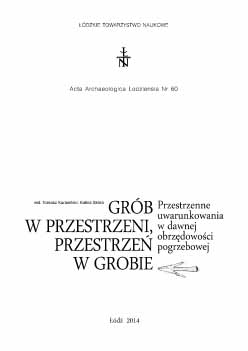Trup nieobecny?... czyli o brakujących szczątkach kostnych w grobach kultury wielbarskiej
The corpse missing?... Or, missing bone remains in graves of the Wielbark Culture
Author(s): Kalina SkóraSubject(s): History, Archaeology
Published by: Łódzkie Towarzystwo Naukowe
Keywords: the Wielbark Culture; funerary rituals; cenotaphs; symbolic graves; anthropological analyses
Summary/Abstract: In cemeteries of the Wielbark Culture we notice inhumation or cremation graves, in which there are either no human bones, or merely a small part of them (cenotaphs, symbolic graves, partial burials). This paper discusses reasons behind this absence. First of all, we face the following problem: do we observe a custom of commemoration of the absent dead in the funeral rite, or is it rather our present-day cultural construct? At the moment, it seems rather impossible to correctly describe this phenomenon and to identify its scope. It is first of all natural causes leading to a decomposition of the skeleton that can be made responsible for the absence of bones in the grave. On the other hand, a custom of commemorating of the absent dead must be considered. This custom is testified to in many societies, regardless of their level of civilisation. A death in circumstances which render a burial by relatives or in a home cemetery impossible is not an uncommon phenomenon, especially in turbulent times of military conflicts or in periods of migrations. An empty grave can also be a result of exhumation, undertaken for many a reason: migration and a need for transposition of remains, annihilation of remains of the dead due to personal animosities, for the purpose of political or religious ostentation, post mortem penal activities or anti-vampire practices. A removal of the dead from the grave can be an element of actions which are included in the term of damnatio memoriae. Throwing away of the dead from their places of rest can be a result of new orders, be it political or social ones. Bodies may have also been removed during a robbery. The paper also discusses the issue of a too small weight of burnt human bones which found their way to cremation graves in cemeteries of the Wielbark Culture. The average weight of bones calculated for all the cemeteries which were included in the analysis (from 8.7 g – Kutowa, to 1092 g – Grębocin) significantly differs from expected values (c. 1.5-3 kg, depending on the age and sex). An analogously low result was received for mass graves, where the presence of bones of two (usually) or more dead persons (sporadically) was identified. A low weight of bones in cremation graves can also be due to circumstances and ways of cremation or to taphonomic processes. Another possibility implies that only part of ashes was put into the grave, while for the remaining part other possible ways of depositions are proposed, such as, among others, storing in houses or scattering in various places: in necropoles, throwing into watercourses (as a particular form of sacrifice), a burial of the dead in several graves, deposition in the border space of inhabited places, scattering in the landscape or division of remains between mourners as a physical trace of memory. One of possible reasons for scattering of burnt remains may be a need for a quicker physical destruction of the body.
Journal: Acta Archaeologica Lodziensia
- Issue Year: 2014
- Issue No: 60
- Page Range: 45-68
- Page Count: 24
- Language: Polish

